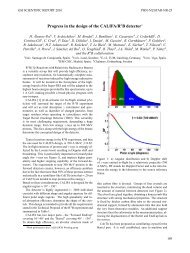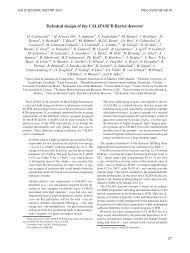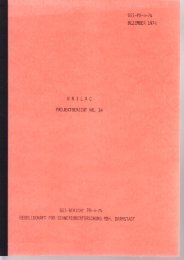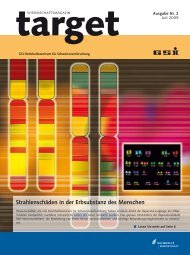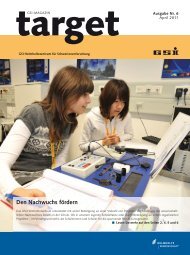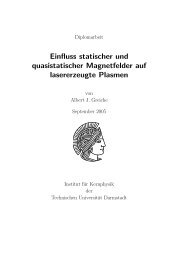download block - GSI Helmholtzzentrum für Schwerionenforschung
download block - GSI Helmholtzzentrum für Schwerionenforschung
download block - GSI Helmholtzzentrum für Schwerionenforschung
Create successful ePaper yourself
Turn your PDF publications into a flip-book with our unique Google optimized e-Paper software.
<strong>GSI</strong>-ACCELERATORS-10 <strong>GSI</strong> SCIENTIFIC REPORT 2009<br />
ESR Operation and Development<br />
C. Dimopoulou, A. Dolinskii, O. Gorda, V. Gostishchev, R. Hettrich, C. M. Kleffner,<br />
S. Litvinov, F. Nolden, P. Petri, U. Popp, I. Schurig, M. Steck<br />
In the framework of machine developments at the ESR<br />
two new modes of operation were tested. After first unsuccessful<br />
attempts to demonstrate the slow extraction of a<br />
decelerated beam, the slow extraction test was performed<br />
at higher energy. The main advantage is a much shorter<br />
cycle time allowing faster variation of parameters and easier<br />
diagnostics in the HITRAP linac. With improved orbit<br />
corrections and after careful tuning of quadrupole and<br />
sextupole magnets the resonant extraction of a cooled bare<br />
argon beam at an energy of 100 MeV/u could be demonstrated.<br />
The extraction was performed by tuning the main<br />
quadrupoles such that the tune was close to the third order<br />
resonance Qx = 2.333, subsequent slow linear variation of<br />
two sextupoles shifted the beam tune across the resonance.<br />
Particles which are excited to large betatron amplitude enter<br />
the electrostatic septum which deflects them into the<br />
extraction channel. Extraction times up to 10 s could be<br />
achieved easily. The required magnet setting for the resonant<br />
extraction is thus known and can be applied, if slow<br />
extraction of bare decelerated ions is needed in the future.<br />
The second new mode followed a request to have shorter<br />
cycle times for HITRAP commissioning with a 4 MeV/u<br />
beam delivered to the HITRAP linac. It resulted in tests of<br />
the direct transfer of a Unilac beam using SIS and ESR as<br />
single pass beamlines. Although this transfer was tried out<br />
several times with different ion species, all tests resulted in<br />
beam loss after the first dipole magnet in the ESR. The tests<br />
were seriously hampered by the fact, that no diagnostics are<br />
available to detect the low energy beam in the ESR during<br />
a single pass, neither destructively nor non-destructively.<br />
Various problems of this mode could be identified. The<br />
power converters of the beam line magnets between SIS<br />
and ESR were not foreseen to operate at such low magnetic<br />
rigidity. The focussing of the beam through SIS and the<br />
beamline is different from normal operation and the beam<br />
could not be matched to the standard ESR optical setting.<br />
At the location of the main beam loss, the electrodes of the<br />
stochastic cooling system limit the acceptance, even further<br />
impeding the passage of the unmatched beam.<br />
The HITRAP commissioning was regularly continued in<br />
two <strong>block</strong>s of about five days with bare nickel and xenon<br />
beams decelerated in the usual way from 400 to 4 MeV/u.<br />
Up to 2 × 10 7 nickel ions could be decelerated to 4 MeV/u<br />
with an efficiency of 15 % for the deceleration in the complex<br />
deceleration cycle. For xenon, limited by the shorter<br />
lifetime in the residual gas, 2 × 10 6 ions could be decelerated,<br />
the total cycle time could be reduced to 45 s.<br />
Various experiments were performed at the internal<br />
target of the ESR. A nuclear physics experiment used<br />
94 Ru 44+ ions decelerated from 100 to 10 and 9 MeV/u<br />
138<br />
<strong>GSI</strong>, Darmstadt, Germany<br />
and a dense hydrogen target. The reaction products of the<br />
(p, γ) reaction were studied with particle detectors installed<br />
in a section with large dispersion behind the target. Several<br />
high charge states (89+, 90+, 91+) of uranium and different<br />
energies in the range 120 to 400 MeV/u were used in<br />
an atomic physics experiment at the internal target.<br />
The experiment on time dilatation with precision laser<br />
spectroscopy of lithium ions was continued. A half life<br />
of the 59 MeV/u Li 1+ beam of 60 s confirmed that the<br />
problem with a tiny leak in the ultrahigh vacuum system<br />
of the ESR, which had hampered the experiment in previous<br />
years [1], has been solved.<br />
The mode for the production of rare isotope beams right<br />
in front of the ESR, tested before [1], was used for an experiment<br />
of dielectronic recombination of cooled lithium-like<br />
uranium. A beam of helium-like 237 U 90+ at 186 MeV/u<br />
was produced in a 10 mm thick beryllium target from a<br />
381 MeV/u primary 238 U 73+ bunch of up to 2 × 10 9 ions.<br />
The helium-like charge state injected and stored close to the<br />
central orbit was used to breed lithium-like uranium ions by<br />
capture of electrons from the comoving high intensity electron<br />
beam (electron current 450 mA). After 2-5 minutes<br />
1 − 2 × 10 5 helium-like ions had captured one more electron<br />
circulating on an orbit radially further outside. These<br />
comoving 237 U 89+ ions were then moved to the central orbit<br />
by ramping all magnets of the ring to a higher field with<br />
a field increase of about 1 %. During this manipulation the<br />
electron cooling was continued at fixed energy. Finally, the<br />
selected particles circulated on the central orbit, whereas<br />
most other beam components, which were injected together<br />
with the wanted particles, were removed by inserting fast<br />
scrapers from inner and outer side into the ring acceptance.<br />
The lithium-like charge state was then used for measurements<br />
of dielectronic recombination spectra by scanning<br />
the energy of the comoving electron beam thus varying the<br />
relative velocity between ions and electrons. This measurement<br />
cycle was repeated for 236 U 89+ and 238 U 89+ in order<br />
to detect small shifts of resonant lines for different isotopes.<br />
For future experiments with single or few ions a new<br />
Schottky noise pick-up based on a pill box type cavity with<br />
a resonant frequency around 250 MHz has been designed<br />
and constructed. The stainless steel body was copper plated<br />
at <strong>GSI</strong>. A quality factor of around 1000 should considerably<br />
increase the signal to noise ratio compared to the existing<br />
broad band Schottky pick-up. The cavity will be tested<br />
and prepared for installation in the ESR early 2010.<br />
References<br />
[1] C. Dimopoulou et al., <strong>GSI</strong> Report 2009-1.





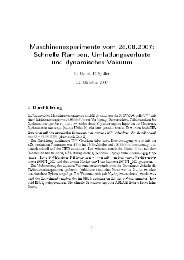
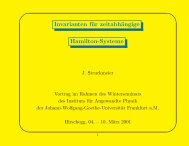
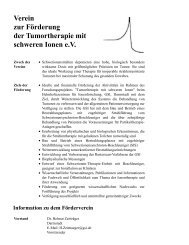
![GS I -P-]-17 - GSI Helmholtzzentrum für Schwerionenforschung](https://img.yumpu.com/20698964/1/184x260/gs-i-p-17-gsi-helmholtzzentrum-fur-schwerionenforschung.jpg?quality=85)

